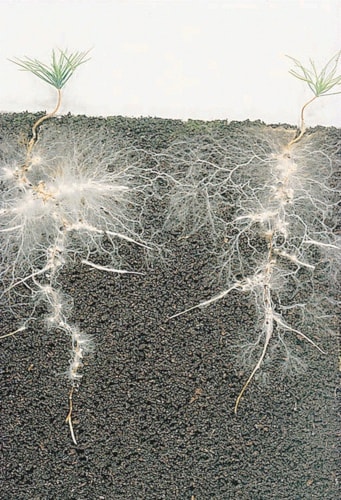Trees can talk.
Out of sight, some tree roots use an underground network of fungi to trade water and nutrients, or even to send defence signals warning of pests and disease.
Older ‘mother’ trees nurse seedlings as they rise above the shaded understory. Dying trees send out nutrients to give the young a fighting chance.
Even some trees of different species can connect, though even the best-connected ‘mother’ trees tend to favour their kin.
Haida Gwaii may be next in line for the ‘Mother Tree Project’ — a major study that will test some of the ways forestry practices might be re-designed in light of such findings. In a landmark paper by University of British Columbia’s Suzanne Simard, the journal Nature called it the “wood-wide web.”
Speaking to a crowd that packed the gym bleachers at Gudangaay Tlaats’gaa Naay on April 11, Simard said her early work was inspired by a 1983 lab study that used pine seedlings growing in glass boxes to show how water can move tree-to-tree over threads of mycorrhizal fungi — the same fungal networks that sprout mushrooms. She has spent 25 years on the subject.
“I think that a lot of people laughed at this study at first,” said Simard, who once struggled to get funding to show similar connections in an actual forest.
“It’s kind of weird. It’s not how we usually think of plants.”
Co-funded by UBC, the Ministry of Forests, major forestry companies and others, the study so far includes 10 sites up and down interior B.C., but Simard said they hope to add coastal sites here on Haida Gwaii and near Bella Bella.
Anticipating climate change, the project includes a range of climactic regions, and will test tree seeds from warmer areas as well as seeds the B.C. forest service hopes will improve productivity.
While Simard and others made several key findings about trees and fungal networks in the 1990s, she said the research is still pretty much ignored in B.C.’s forestry industry.
“Foresters don’t think this way,” said Simard, who grew up in a logging family in the Monashee Mountains and began her own career as a forester tasked with regrowing clearcuts.
“They think of trees as individuals, and plant them in squares and rows,” she said.
For example, Simard showed an aerial photo taken over a former old-growth spruce forest in northeast B.C. that was cut and re-planted with a single species: lodgepole pine.
The picture shows a perfect rectangle of red trees surrounded by green. It’s a block of second-growth pine that was wiped out entirely by the mountain pine beetle.
“We take out all these patches of trees, plant one or two or three species, and pretend that it’s going to grow well,” said Simard.
“What if it doesn’t, actually, because we’re not treating them as complex ecosystems?”
Had foresters mixed in more trees species, or left some of the larger, well-connected ‘mother’ trees in place, Simard said the forest might have had a better chance.
One of her key studies showed that trees send more carbon, nitrogen, and water to neighbouring trees under stress.
Another study looked at how even trees of different species, such as Douglas fir and ponderosa pine, use fungal networks to send biochemical signals for making terpenes — the disease- and pest-fighting compounds that form the active ingredient in turpentine.
Across B.C., the mountain pine beetle epidemic has killed 18 million hectares of forest, which is a huge area nearly the size of Oregon. The response was to quickly salvage as much of the beetle-killed wood as possible.
“I’ve always been really concerned about that,” said Simard.
“I’m wondering if we are shooting ourselves in the foot by cutting down dying trees before they are able to pass on their legacy, or their carbon, to other seedlings in the understory.”
In the fledgling area of “complexity science,” Simard pointed out echoes of indigenous ecological knowledge.
Teresa Ryan, Smhayetsk, spoke before Simard about how, over millennia, cultures of indigenous peoples such as her own Tsimshian Nation became interconnected with local ecologies.
A researcher and policy advisor in resource management, Ryan spoke about the complex system of clans and house groups that controlled watersheds and tributaries, and adapted in times of scarcity to avoid a concentrated impact.
Ryan also gave the example of the stone fishing weirs used by Heiltsuk and other coastal First Nations that passively limited the salmon catch, allowing enough to return upstream to spawn.
The legacy of such fishing practices is taking on new significance given other new scientific findings that show how much nitrogen in coastal forests is actually derived from the fish carcasses hauled up by bears and other predators — in one B.C. study, Ryan pointed out, researchers found a Sitka spruce with 80 per cent marine-derived nitrogen.
Simard said that despite such findings, B.C. forestry practice still tends to treat the land as a series of disconnected parts. Science is only beginning to understand just how deeply people shape forest ecosystems.
Still, Simard said discovering that the above-ground forest is often just half the picture has caught much attention, not only from researchers, but also the wider public.
“There’s a great deal of public awareness around this new discovery, and a great deal of hope, at least in me, that we can change the way we are [managing] our forestry to take this kind of community effect into account,” she said.
